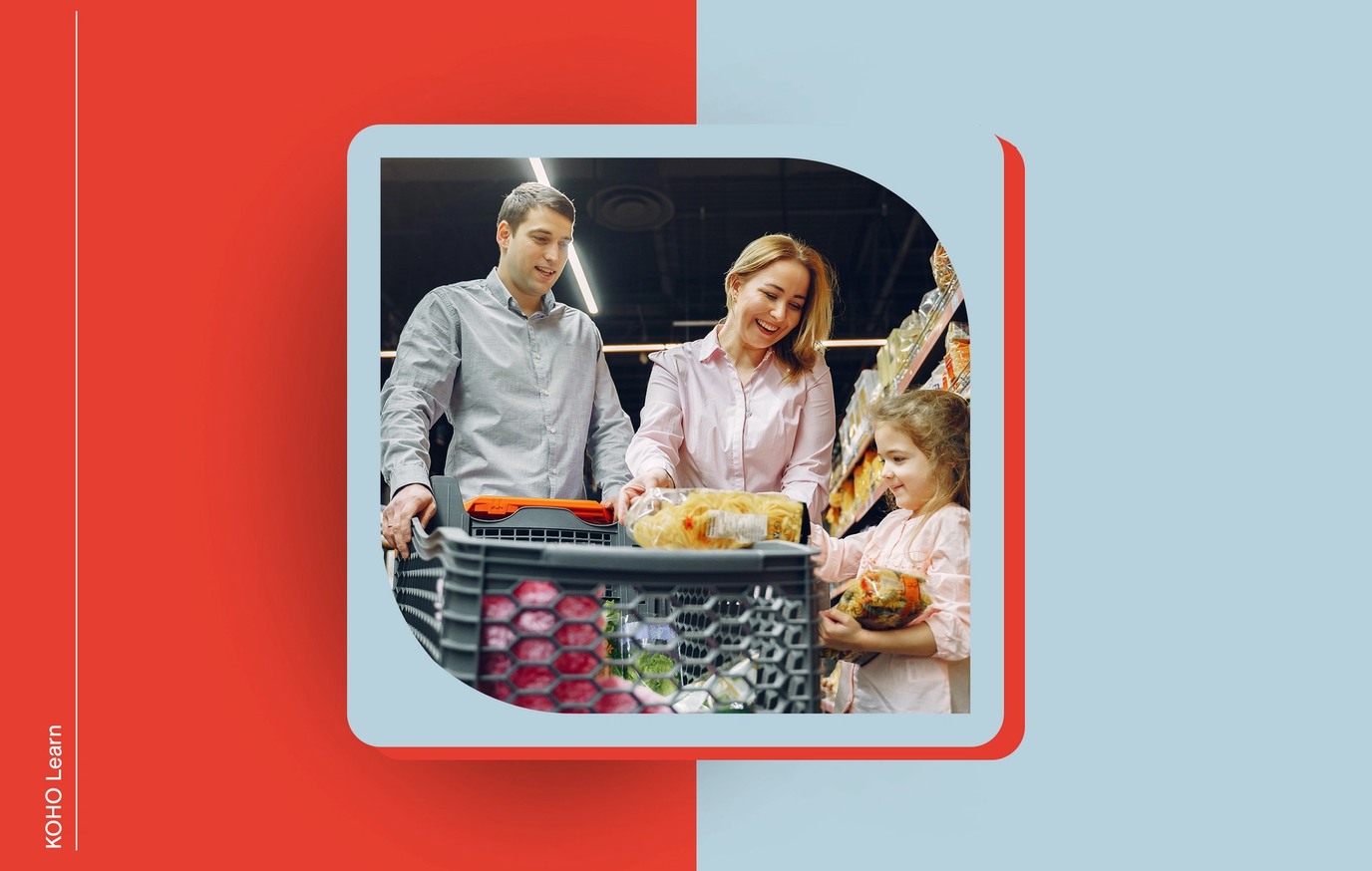
Groceries have become a big-ticket expense for many Canadians these days, with food prices up 10.4% year-over-year in January 2023, according to Statistics Canada.
And just when you thought your budget couldn’t be squeezed any more, food prices are predicted rise by 5% to 7% this year, according to Canada's Food Price Report 2023, with the average family of four expected to spend up to $16,288 per year on food.
In the face of inflation and grocery store sticker shock, cash back credit cards are one way to get a modest return on purchases you’re making anyway – as long as you pay off your credit card balance in full every month (or you can use KOHO and earn cash back on purchases using your own money. More on that later!). Keep reading to learn more about how to maximize your cash back at the grocery store and how to choose the right card for you.
Can you get cash back at the grocery store?
Cash back is a popular credit card rewards option, and all of Canada’s major banks and credit unions offer cash back credit cards. Some cash back credit cards have a flat cash back rate, while others offer a higher rate in particular spending categories such as groceries, gas and restaurants. Other cards allow you to choose which spending categories want to earn higher cash back rate on, with the option to change it up.
With a cash back credit card, you basically get a rebate on a percentage of each purchase you make. Depending on the card, your cash back rewards are deposited into your bank account or applied as a credit on your card monthly or annually.
For example, if you spend $150 at the grocery store on a credit card that earns 4% cash back on groceries, you’ll get $6 back on your purchase. Using the example of the average family of four, spending $16,288 per year at the grocery store would earn $651.52 in cash back. It’s not a fortune, but it can add up and is a way to shave off a little value from money you’re spending anyway.
Some grocery stores like Costco, Walmart and Loblaws have branded credit cards with cash back or their own rewards programs to incentivize shoppers to do all their shopping in one place.
How to maximize your cash back rewards
If you’re looking for a cash back credit card specifically for grocery shopping, you’re in luck – groceries are a popular spending category, and many credit cards offer higher cash back rates for eligible grocery store purchases. Here are a few ways to maximize your cash back credit card rewards:
Find a card with a higher cash-back rate for groceries. Since groceries are essential, many cash back credit cards offer up to 4% back at grocery stores. You may earn a lower cash back rate in other spending categories – for example, 4% cash back on groceries and gas but 1% cash back on everything else – but it might be worth it if groceries are your biggest expense. Some cards with higher cash back rates charge an annual fee, so you’ll need to decide if it works for your budget based on how much value you get out of the card.
Sign-up bonus. Many credit cards entice new customers to sign up by offering welcome bonuses, such as waiving the annual fee for the first year or offering a bonus cash back rate, usually for a certain period of time up to a certain spending or cash back limit. If you’re looking to sign up for a new credit card, be patient and do your research to find the best deal.
Be aware of merchant category codes. One of the most important parts of using credit card rewards correctly is understanding that it’s not about what you buy, but where you buy it. Credit card companies give all businesses a four-digit merchant category code (MCC). Grocery stores are categorized as MCC 5411. This means that if your cash back credit card offers a higher cash back rate on groceries, only purchases from stores categorized as MCC 5411 are considered eligible “grocery store” purchases.
For example, Tylenol is typically considered a drugstore item, but if you purchase it from a grocery store classified as MCC 5411, it counts as a grocery store purchase. It’s also important to know that hybrid stores like Costco and Walmart that sell groceries and other goods may not be classified as MCC 5411, depending on the location.
Always pay off your card. Credit card rewards only work in your favour if you pay off your balance in full every month. If you carry a balance and pay interest on it, it takes away from any cash back rewards you earn. The goal is to earn cash back on money within your monthly budget that you’re spending on essentials, not to rack up debt.
How to choose a grocery credit card
Choosing the best credit card for groceries is all about finding one that suits your spending habits. Think about whether you want to pay an annual fee and where you spend the most money (groceries, gas, bills, etc.).
You also need to consider where you shop for groceries and what credit card network(s) they accept. For example, Costco stores in Canada only accept Mastercard credit cards. Loblaws accepts Visa and Mastercard. Walmart, Sobeys and Metro accept Visa, Mastercard and American Express.
Loblaw Companies Limited, Metro Inc. and Empire Company Limited own the majority of grocery store chains under various names across Canada, so check beforehand to see which credit card network or networks your preferred stores accept.
If you’re looking for the spending power of a credit card without worrying about debt or interest, there’s also KOHO, a spending account with a reloadable prepaid Mastercard. It works just like a credit card and can be used anywhere Mastercard is accepted, but draws from money you’ve deposited into your KOHO account.
There are three tiers of KOHO accounts (Easy, Essential and Extra), which offer a number of full-service benefits as well as cash back:
KOHO Easy: With no monthly fee, earn 1% cash back on groceries, transportation, plus extra cash back at selected merchants.
KOHO Essential: For a monthly fee of $4/month or $48/year (includes a 30-day free trial), earn 1% cash back on groceries, transportation, eating and drinking and 0.25% back on all other purchases. Plus, get extra cash back at selected merchants.
KOHO Extra: For a monthly fee of $9/month or $84/year (includes a 30-day free trial), earn 2% cash back on groceries, transportation, eating and drinking, and 0.5% cash back on all other purchases. Plus, get extra cash back at selected merchants.
Grocery stores that have cash back
While you’re earning cash back rewards on your credit card, there are times when you might need to withdraw cold, hard cash from your bank account. If you happen to be grocery shopping and aren’t near an ATM, many grocery stores offer the option of getting cash back at the register when you pay with your debit card.
When it’s time to pay for your items, let the cashier know you would like cash back and tell them the amount you need. The cash back amount will be added to the transaction total, and you can pay with your debit card as usual. Once the transaction clears, the cashier will hand you the cash. Remember, this type of cash back has nothing to do with your credit card, and can only be used with debit transactions.

About the author
Jane Switzer is a writer and editor with more than a decade of experience producing content for major Canadian newspapers, magazines, fintech companies and banks. Jane got her start working in journalism as a reporter and copy editor before transitioning to content writing, editing and SEO.
Read more about this author